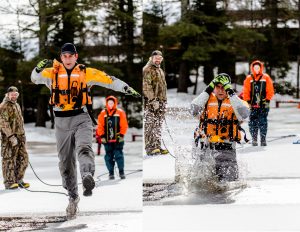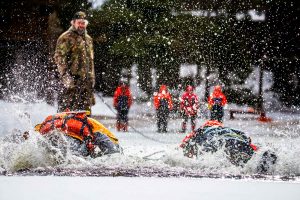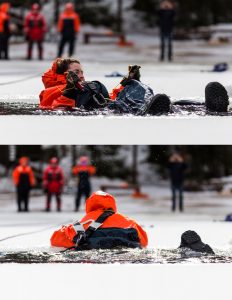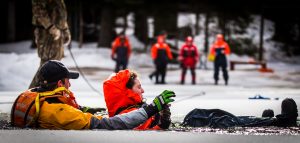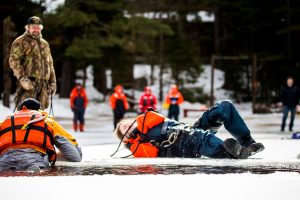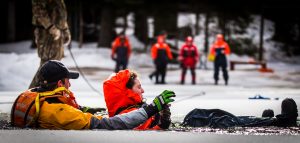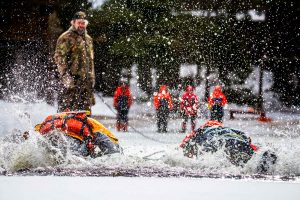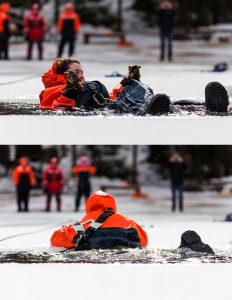Joe’s Guide To Understanding In-Water Ice Self-Rescue Training
For a number of years now Bark Lake has been hosting Working On Ice safety training. This is great training for anyone who works, plays, or travels on ice. The course covers a wide range of topics from “How Thick Does Ice Have To Be?” to “What is Hypothermia?” to “How to I Get Myself Out of Water If I’ve Fallen Through Ice?”.
While most people have no problem with the first half of the day (classroom and theory work), they become increasingly nervous as the afternoon approaches.
Afternoons are for practical training.
Fear is often caused by the unknown. To help demystify the immersion experience I’ve decided to create Joe’s Guide To Understanding In-Water Ice Self-Rescue Training.
Myth: I’m going to do this alone.
Fact: You will have a support team in place to keep you safe, both physically and emotionally.
Take a close look at the woman on the right. She’s wearing a safety harness.
Take a close look at the woman’s harness. It has clips.
Take a close look at the woman’s harness’ clips. It’s a bit tricky to see, but there is a rope there. And that rope, when she’s in the water, will be connected to the hands of her on-land support.
There is another important piece of safety equipment, and he’s wearing a baseball cap. Scott is talking with the student, going over what she can expect when she jumps in. He makes sure that our student is ready for what’s to come.
Myth: The instructor is going to ask me to do things that he would never-ever do.
Fact: The instructor is going to ask you to do things he’s done many-many times before.
Our instructor, Scott, is more than willing to put his money where is mouth is… or rather his body in the ice-cold water.
Just remember: When engaging in an in-water training course, hold onto your hat!
Myth: They are going to push me into the water.
Fact: You are going to challenge yourself into the water.
At Bark Lake we believe that all students learn better when they actively want to be challenge; it’s the key principle in Choose Your Challenge.
As an intrepid outdoors professional or simply as someone who wants to take some training, you have the opportunity to walk away from the immersion part of the course. While it’s important to be trained in a real world situation, it’s more important that you move at your own speed. Need to take a couple of minutes to psych yourself up? Go ahead! It’s all about choosing your challenge.
Myth: Once I’m in the water I’ll have only moments to get out of the water.
Fact: You have more time then you think.
Once you’re in the water it’s important to keep calm and think things through. For many first timers the initial couple-a-few moments can be terrifying. Instructor Scott is telling the student to relax, let the floater suit do it’s job, find her rescue picks, and to plan her next move.
Myth: The instructor is going to hold my hand the entire time. I’m not going to do anything on my own.
Fact: The instructor wants to see you succeed by completing your own self-rescue.
After everything is under control, it’s the You Show! Get your picks, turn on to your belly, and get yourself out of the water!
Myth: I don’t have the upper body strength to pull myself out of the water.
Fact: You do have the leg strength to push yourself out of the water.
Remember when you were first learning to swim? Most likely the instructor had you hold on to the side of the wall and kick with all your might. In essence that’s what you need to do here; kick, kick, and kick some more.
Myth: Once I’m out of the water I can stand up and walk away.
Fact: Once you are out of the water you are still in training.
This course is designed to keep you safe in the event that you break through the ice. The training isn’t over until you are safely back on dry ground. What does this mean for you, the student?
It means that once you have kicked, kicked, kicked your way out of the water you are not safe. You need to roll away from the open hole. It may not seem like a big deal, but trust me, it just might save your life. (And don’t worry if you forget to roll, Instructor Scott is right there… probably still in the water… to remind you.)
Hopefully this short story has unveiled some of the mysteries of the Working On Ice course. If you would like to know more about this course, or any other courses, please feel free to reach out to us.
~ Joe
PS: We are running another Working On Ice course on March 1st. Spaces are filling up fast!

